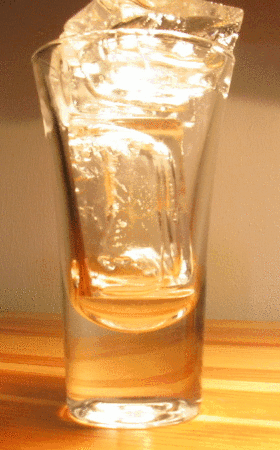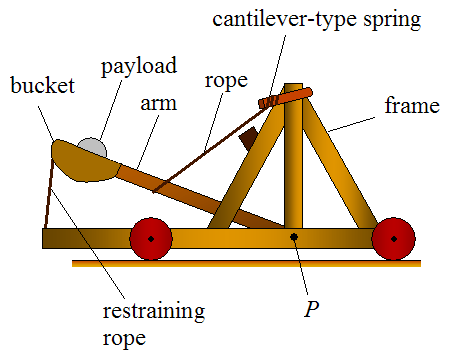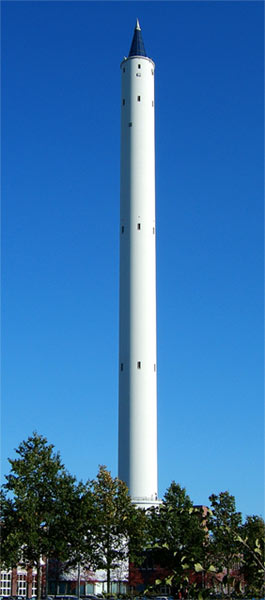|
Drop Tube
In physics and materials science, a drop tower or drop tube is a structure used to produce a controlled period of weightlessness for an object under study. Air bags, polystyrene pellets, and magnetic or mechanical brakes are sometimes used to arrest the fall of the experimental payload. In other cases, high-speed impact with a substrate at the bottom of the tower is an intentional part of the experimental protocol. Not all such facilities are towers: NASA Glenn's Zero Gravity Research Facility is based on a vertical shaft, extending to below ground level. Typical operation For a typical materials science experiment, a sample of the material under study is loaded into the top of the drop tube, which is filled with inert gas or evacuated to create a low-pressure environment. Following any desired preprocessing (e.g. induction heating to melt a metal alloy), the sample is released to fall to the bottom of the tube. During its flight or upon impact the sample can be c ... [...More Info...] [...Related Items...] OR: [Wikipedia] [Google] [Baidu] |
Physics
Physics is the natural science that studies matter, its fundamental constituents, its motion and behavior through space and time, and the related entities of energy and force. "Physical science is that department of knowledge which relates to the order of nature, or, in other words, to the regular succession of events." Physics is one of the most fundamental scientific disciplines, with its main goal being to understand how the universe behaves. "Physics is one of the most fundamental of the sciences. Scientists of all disciplines use the ideas of physics, including chemists who study the structure of molecules, paleontologists who try to reconstruct how dinosaurs walked, and climatologists who study how human activities affect the atmosphere and oceans. Physics is also the foundation of all engineering and technology. No engineer could design a flat-screen TV, an interplanetary spacecraft, or even a better mousetrap without first understanding the basic laws of physics ... [...More Info...] [...Related Items...] OR: [Wikipedia] [Google] [Baidu] |
Vomit Comet
A reduced-gravity aircraft is a type of fixed-wing aircraft that provides brief near-weightless environments for training astronauts, conducting research and making gravity-free movie shots. Versions of such airplanes were operated by the NASA Reduced Gravity Research Program, and one is currently operated by the Human Spaceflight and Robotic Exploration Programmes of the European Space Agency. The unofficial nickname "vomit comet" became popular among those who experienced their operation. History Parabolic flight as a way of simulating weightlessness was first proposed by the German aerospace engineer Fritz Haber and the German physicist Heinz Haber in 1950. Both had been brought to the US after World War II as part of Operation Paperclip. As well, Shih-Chun Wang studied nausea in astronauts for NASA, which helped lead to the creation of the vomit comet. Parabolic flights are sometimes used to examine the effects of weightlessness on a living organism. While humans are ... [...More Info...] [...Related Items...] OR: [Wikipedia] [Google] [Baidu] |
Molten
Melting, or fusion, is a physical process that results in the phase transition of a substance from a solid to a liquid. This occurs when the internal energy of the solid increases, typically by the application of heat or pressure, which increases the substance's temperature to the melting point. At the melting point, the ordering of ions or molecules in the solid breaks down to a less ordered state, and the solid "melts" to become a liquid. Substances in the molten state generally have reduced viscosity as the temperature increases. An exception to this principle is the element sulfur, whose viscosity increases in the range of 160 °C to 180 °C due to polymerization. Some organic compounds melt through mesophases, states of partial order between solid and liquid. First order phase transition From a thermodynamics point of view, at the melting point the change in Gibbs free energy ''∆G'' of the substances is zero, but there are non-zero changes in ... [...More Info...] [...Related Items...] OR: [Wikipedia] [Google] [Baidu] |
Lead Shot
Shot is a collective term for small spheres or pellets, often made of lead. These were the original projectiles for shotguns and are still fired primarily from shotguns and less commonly from riot guns and grenade launchers, although shot shells are available in many pistol calibers in a configuration called " birdshot", " rat-shot", or " snake shot". Lead shot is also used for a variety of other purposes such as filling cavities with dense material for weight/balance. Some versions may be plated with other metals. Lead shot was originally made by pouring molten lead through screens into water, forming what was known as "swan shot", and, later, more economically mass-produced at higher quality using a shot tower. The ''Bliemeister method'' has supplanted the shot tower method since the early 1960s. Manufacture Producing lead shot from a shot tower was pioneered in the late 18th century by William Watts of Bristol who adapted his house on Redcliffe Hill by adding a three- st ... [...More Info...] [...Related Items...] OR: [Wikipedia] [Google] [Baidu] |
Shot Tower
A shot tower is a tower designed for the production of small-diameter shot balls by free fall of molten lead, which is then caught in a water basin. The shot is primarily used for projectiles in shotguns, and for ballast, radiation shielding, and other applications for which small lead balls are useful. Shot making Process In a shot tower, lead is heated until molten, then dropped through a copper sieve high in the tower. The liquid lead forms tiny spherical balls by surface tension, and solidifies as it falls. The partially cooled balls are caught at the floor of the tower in a water-filled basin.. The now fully cooled balls are checked for roundness and sorted by size; those that are "out of round" are remelted. A slightly inclined table is used for checking roundness. To make larger shot sizes, a copper sieve with larger holes is used. The maximum size is limited by the height of the tower, because larger shot sizes must fall farther to solidify. A shot tower with ... [...More Info...] [...Related Items...] OR: [Wikipedia] [Google] [Baidu] |
Leaning Tower Of Pisa
The Leaning Tower of Pisa ( it, torre pendente di Pisa), or simply, the Tower of Pisa (''torre di Pisa'' ), is the ''campanile'', or freestanding bell tower, of Pisa Cathedral. It is known for its nearly four-degree lean, the result of an unstable foundation. The tower is one of three structures in the Pisa's Cathedral Square ('' Piazza del Duomo''), which includes the cathedral and Pisa Baptistry. The height of the tower is from the ground on the low side and on the high side. The width of the walls at the base is . Its weight is estimated at . The tower has 296 or 294 steps; the seventh floor has two fewer steps on the north-facing staircase. The tower began to lean during construction in the 12th century, due to soft ground which could not properly support the structure's weight. It worsened through the completion of construction in the 14th century. By 1990, the tilt had reached 5.5 degrees. The structure was stabilized by remedial work between 1993 and 2001, which redu ... [...More Info...] [...Related Items...] OR: [Wikipedia] [Google] [Baidu] |
Galileo
Galileo di Vincenzo Bonaiuti de' Galilei (15 February 1564 – 8 January 1642) was an Italian astronomer, physicist and engineer, sometimes described as a polymath. Commonly referred to as Galileo, his name was pronounced (, ). He was born in the city of Pisa, then part of the Duchy of Florence. Galileo has been called the "father" of observational astronomy, modern physics, the scientific method, and modern science. Galileo studied speed and velocity, gravity and free fall, the principle of relativity, inertia, projectile motion and also worked in applied science and technology, describing the properties of pendulums and " hydrostatic balances". He invented the thermoscope and various military compasses, and used the telescope for scientific observations of celestial objects. His contributions to observational astronomy include telescopic confirmation of the phases of Venus, observation of the four largest satellites of Jupiter, observation of Satu ... [...More Info...] [...Related Items...] OR: [Wikipedia] [Google] [Baidu] |
Vacuum
A vacuum is a space devoid of matter. The word is derived from the Latin adjective ''vacuus'' for "vacant" or " void". An approximation to such vacuum is a region with a gaseous pressure much less than atmospheric pressure. Physicists often discuss ideal test results that would occur in a ''perfect'' vacuum, which they sometimes simply call "vacuum" or free space, and use the term partial vacuum to refer to an actual imperfect vacuum as one might have in a laboratory or in space. In engineering and applied physics on the other hand, vacuum refers to any space in which the pressure is considerably lower than atmospheric pressure. The Latin term ''in vacuo'' is used to describe an object that is surrounded by a vacuum. The ''quality'' of a partial vacuum refers to how closely it approaches a perfect vacuum. Other things equal, lower gas pressure means higher-quality vacuum. For example, a typical vacuum cleaner produces enough suction to reduce air pressure by around 20%. But ... [...More Info...] [...Related Items...] OR: [Wikipedia] [Google] [Baidu] |
Catapult
A catapult is a ballistic device used to launch a projectile a great distance without the aid of gunpowder or other propellants – particularly various types of ancient and medieval siege engines. A catapult uses the sudden release of stored potential energy to propel its payload. Most convert tension or torsion energy that was more slowly and manually built up within the device before release, via springs, bows, twisted rope, elastic, or any of numerous other materials and mechanisms. In use since ancient times, the catapult has proven to be one of the most persistently effective mechanisms in warfare. In modern times the term can apply to devices ranging from a simple hand-held implement (also called a "slingshot") to a mechanism for launching aircraft from a ship. The earliest catapults date to at least the 7th century BC, with King Uzziah, of Judah, recorded as equipping the walls of Jerusalem with machines that shot "great stones". Catapults are mentioned in Yajurv ... [...More Info...] [...Related Items...] OR: [Wikipedia] [Google] [Baidu] |
University Of Bremen
The University of Bremen (German: ''Universität Bremen'') is a public university in Bremen, Germany, with approximately 23,500 people from 115 countries. It is one of 11 institutions which were successful in the category "Institutional Strategies" of the Excellence Initiative launched by the Federal Government and the Federal States in 2012. The university was also successful in the categories "Graduate Schools" and "Clusters of Excellence" of the initiative. Some of the paths that were taken in the early days of the university, also referred to as the "Bremen model", have since become characteristics of modern universities, such as interdisciplinary, explorative learning, social relevance to practice-oriented project studies which enjoy a high reputation in the academic world as well as in business and industry. History Though Bremen became a university city only recently, higher education in Bremen has a long tradition. The Bremen Latin School was upgraded to "Gymnasium Acad ... [...More Info...] [...Related Items...] OR: [Wikipedia] [Google] [Baidu] |
Fallturm Bremen
Fallturm Bremen is a drop tower at the Center of Applied Space Technology and Microgravity at the University of Bremen in Bremen. It was built between 1988 and 1990, and includes a 122-metre-high drop tube (actual drop distance is 110 m), in which for 4.74 seconds (with release of the drop capsule), or for over 9 seconds (with the use of a catapult, installed in 2004) weightlessness can be produced. The entire tower, formed out of a reinforced concrete shank, is 146 metres high. The 122-metre drop tube is free-standing within the concrete shell, in order to prevent the transmission of wind-induced vibrations, which could otherwise result in the airtight drop capsule hitting the walls. The drop tube is pumped down prior to every free-fall experiment to about 10 Pa (~ 1/10 000 atmosphere An atmosphere () is a layer of gas or layers of gases that envelop a planet, and is held in place by the gravity of the planetary body. A planet retains an atmosphere when t ... [...More Info...] [...Related Items...] OR: [Wikipedia] [Google] [Baidu] |
Marshall Space Flight Center
The George C. Marshall Space Flight Center (MSFC), located in Redstone Arsenal, Alabama ( Huntsville postal address), is the U.S. government's civilian rocketry and spacecraft propulsion research center. As the largest NASA center, MSFC's first mission was developing the Saturn launch vehicles for the Apollo program. Marshall has been the lead center for the Space Shuttle main propulsion and external tank; payloads and related crew training; International Space Station (ISS) design and assembly; computers, networks, and information management; and the Space Launch System (SLS). Located on the Redstone Arsenal near Huntsville, MSFC is named in honor of General of the Army George C. Marshall. The center contains the Huntsville Operations Support Center (HOSC), also known as the International Space Station Payload Operations Center. This facility supports ISS launch, payload, and experiment activities at the Kennedy Space Center. The HOSC also monitors rocket launches from ... [...More Info...] [...Related Items...] OR: [Wikipedia] [Google] [Baidu] |








